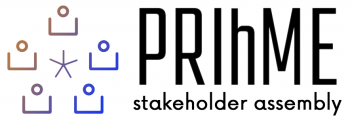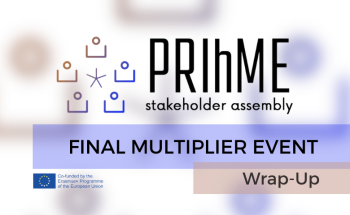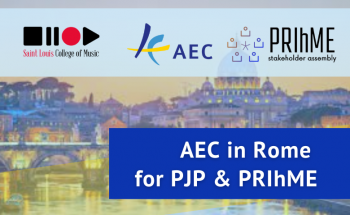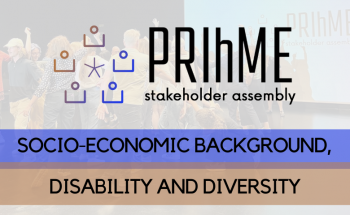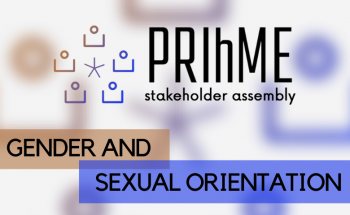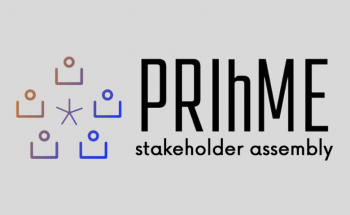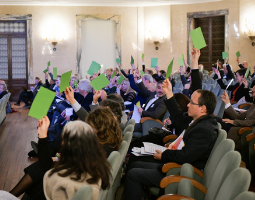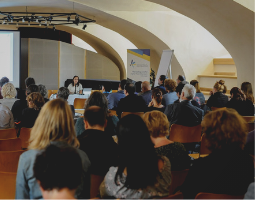PRIhME Recommendations
Thank you for your interest in the recommendations of the PRIhME project! To help you understand how we have worked, we are providing you with
- the Stakeholder Assembly Recommendations, and a narrative for each;
- a summary of our assembly discussions to help contextualise the recommendations.
The narratives reflect what the Assembly members said during our meetings, and are illustrated by literal quotes. Hopefully, this will make the recommendations more human, and help you as you build policy documents and implement them in your institutions.
We also hope that these recommendations inspire you to go further, which is why we have included ‘What’s next?’ In this section, we provide discussion topics, exercises, links to existing practices, and information helping you to take action by becoming your own power relations ambassador! We want to give you the power to empower yourself and others. This section links to different parts of the PRIhME website, a book, an exercise sheet, a glossary, and a toolbox.
Here are some core beliefs that emerged to help explain why we’ve made these recommendations in the first place.
As stakeholders of the PRIhME Assembly:
|
Assembly 1: Power Relations in HME
1.1. We strongly recommend HMEI create networks of care to provide students, teachers, and staff with support for their physical and mental wellbeing.
Creating ‘networks of care’ within the institution means creating a community within the institution. This community consists of teachers, students, staff, as well as external experts in psychology and health, all of whom strive to create spaces of safety, equality and trust. Such a community, in which people use power to listen and empower each other and to create a circle of shared responsibilities constitutes a pathway to creating safer spaces. Feeling safer means being confident about sharing feelings, problems, and topics that are hard to discuss.
The best solution would be to open a Care Centre as a space of dialogue accessible to everyone, with professionals specialised in (mental) health, wellbeing, and managing conflict (psychologists, mediators…). Furthermore, students, teachers and staff need to be aware of the society within the institution, including vulnerable groups such as people with disabilities, minorities, or any other vulnerable group related to class, race, gender, etc.
Such a Care Centre would ideally include a team of professionals, but a good place to start would be to hire at least a counsellor (psychologist). However, as many institutions still do not have the possibility of recruiting a professional in-house, it is possible to contract such services from outside the institution to provide this support.
“If there is no financial possibility within the institution to employ and create networks of specialists, be open to the whole network in the community which may provide resources of care and support for less money or even for free (e.g. NGOs)”
1.2. We urge institutions to explore ways of fostering dialogue by creating safer spaces where issues related to power relations can be discussed openly, without fear or prejudice.
Feeling safer means being confident about sharing feelings, problems, or topics that are not easy to discuss. Care and support in HMEI appear necessary for students to feel free to speak out. In institutions where such a space does not exist, it is often difficult to openly denounce teachers’ problematic practices or inappropriate conduct.
These spaces don’t have to be physical, but can involve simply reserving time for dialogue. They should address the needs of vulnerable groups (people with disabilities, minorities, and any other vulnerable groups related to class, race, gender, etc.). Calling it a safer space rather than a safe space recognises that this is an ongoing process, and that raising or discussing issues will still be challenging for the person doing so.
“Everything begins and ends here” – a participant about setting up a new club or an official group to better represent marginalised groups within the home university.”
“An effective group can make a change and provide comfort and security.”
1.3. We propose the creation of a glossary related to power relations and empowerment, and annual (workshop) sessions to address the issue.
Glossary and vocabulary building is the first step in strengthening understanding of different types of power. Building a power relations vocabulary is just a start in addressing power relations and creating awareness. While some countries are actively engaged with the topic of power relations, in others it is barely acknowledged, be it in HMEs, the arts and education sector, or the society at large.
The glossary helps define important words so as to promote a shared understanding within the academic community: it facilitates analysis of situations by naming them, and assessing and better understanding different perspectives. Such clarity leads to improved communication in defining different types of power. The process of building a shared language also addresses power imbalance itself, making people feel comfortable expressing themselves and thus able to actively participate in potentially controversial or delicate conversations.
“ [A] Glossary is important. It gives us the vocabulary to recognize the meaning behind those words and makes it a ‘real’ thing within the institution.”
1.4. We urge institutions to engage more conversations on the topic of power relations, for example through the development of specific learning modules.
The conversations we have had in PRIhME on power relations have already empowered us. Having such conversations is a positive experience, and even without having a concrete issue to deal with, fosters trust through exploration of different perspectives. It results in less tense conversations when difficult or controversial issues are tackled.
As this process is ongoing, how can we sustain concrete, meaningful dialogue? One first step is to create annual workshops which address power relations positively, making it possible to evaluate and develop outcomes from prior discussions. Including incoming students in these conversations from their first year provides a good transition from secondary school to the university environment, especially if combined with some training on power relations themes, such as discrimination.
These conversations or workshops can be held in a variety of configurations, and can include students, as well as staff and teachers. If the situation permits, the groups can be mixed to create greater balance. Much can be learned from others: inviting alumni creates a good connection to the world outside the institution, and international workshops provide an understanding of varied cultural approaches, some better, some less so, as to resolution of different issues.
“Maybe we didn’t come to definite and effective conclusions because it was not a simple issue, but it was a very positive experience that they talked to each other for a long time.”
1.5. We urge institutions to empower students, teachers, and administrative staff through implementation of obligatory workshops and training to understand and recognize positive and negative aspects of power relations.
Understanding and recognizing aspects of power relations is the first step in addressing its influence on higher music education institutions. Understanding includes learning that power is everywhere, making it complex, with both positive and negative dimensions. Negative aspects include power abuse, harassment or simply not listening; positive aspects include recognising one’s own power, experiences of power used constructively, and productive feedback acquired through listening, trust, and transparency.
Power can be a very positive tool if associated with awareness. Learning about power and power relations creates an understanding of your own position, beyond its most obvious aspects, e.g. as a teacher with your students. Recognising this also gives you power to modify your own use of power and even to empower others.
“The framework for understanding power that was presented was a big takeaway for me”
“Raising awareness is a big opportunity to make the institution a better place for learning and interacting. This will in return produce individuals equipped to lead similar changes elsewhere”
What’s next?
For most of the participants of the first assembly, talking about power relations was a new situation. The recommendations encouraged us to start thinking about power relations, and to enlarge the conversation to include others. If possible, this conversation should be held in a safe, structured and sustainable way.
When you discuss power in all its aspects, you may first need to find the right context – make sure you feel comfortable. Spaces should be created in which students and teachers can feel confident in using a shared language to discuss what can be improved or modified. Along with discussing your personal experiences with power, which may make you feel vulnerable, there are many questions which can engage a wider conversation:
- When do you feel powerful / powerless?
- What have you noticed about how power works?
- What impact do power relations have (on others)?
- What purposes do power relations serve, both positively and negatively?
- How would you describe the difference between power and empowerment?
- How might we cultivate more empowerment?
- How might power be redistributed? What are your wildest ideas to shake things up for the better? Imagine future generations, such as musicians in 2050 – what can they tell us about power from their utopian future?
Useful Resources
More courses and training are needed for teachers, non-teaching staff and students to raise awareness of power relations, to allow them to feel confident about making their voice heard, and to better understand different perspectives. For example, many people do not know how to speak up when they feel threatened, nor do they know what words to use.
Use information that is available: become as informed as possible about the current practices in your institution. Look at what has been written and discussed on Power Relations, or simply read what another faculty or university in your city does (we are not the first!). Here are some resources:
- Power Relations: A great introduction to power is the Robert Chambers’ video – The Elephant in the Room. To see it applied in the context of music, see expert Anna Bull’s paper in the PRIhME Ebook (to be published in March 2024).
- Useful exercises expand on these resources, such as the ones related to Robert Chambers’ video, found in our Exercise sheet.
- To develop a shared vocabulary, consult our Glossary on Power Relations and Gender, as well as the key words described in the PRIhME Ebook.
- The themes of Power, Power relations, Hierarchies and Canon are also explored more in the Information Brief for the First Assembly.
- The AEC has an annotated bibliography to help you go further: by using the tag ‘power relations,’ you will find additional resources.
Action
Specific examples and ideas for Networks of Care, Safe Spaces and Sharing Knowledge can be found in our Power Relations Toolbox. There, you can see how people have taken action in bringing discussions and interventions on Power Relations to their own institutions. Existing practices are also explored and discussed.
- When it comes to Networks of Care, once a month The Royal Irish Academy of Music in Dublin provides a module in holistic performance psychology with mindfulness exercises. In Mannheim’s Popakademie, mental health and body work support is provided for every performance student. There is also a podcast on mental health and mindset for musicians.
- Safe Spaces benefit from clear regulations. Ideally, a transparent system allows for a case to be opened based on an anonymous complaint, after which a clear result is presented, be it with steps taken or consequences applicable to all. Examples of these include Berklee College of Music’s Equity Policy (check the flow-charts!) or the IASPM Code of Conduct.
- When you discuss these themes – which can be challenging, make sure you have a framework. Whether you are talking one-on-one to a colleague, introducing a discussion in the classroom or at a meeting, discussion methods exist. We have made some suggestions in the Exercise Sheet.
The recording of the Assembly 1 can we found here:
Assembly 2: Gender and Sexual Orientation
2.1. We urge HMEI to strive for gender balance in recruitment of all teachers, staff, and students.
Gender roles affect musical disciplines, instruments and departments at HMEIs in different ways. Biases exist in the recruitment of teachers, assessment situations, and among instruments, departments and genres, particularly if one gender dominates. Generally, no matter the composition of a group, women feel they are expected to work harder, whereas in a more female-dominated department, men can be perceived as having to work less hard, considering they bring a welcome balance. Other issues raised include the sense that predominantly female disciplines may be perceived as being of lesser value (for example, music pedagogy being considered of lesser value than performance).
Striving for balance means that while you cannot force a perfect gender equilibrium immediately, you recognise the need to change the status quo and are willing to take measures towards creating a more balanced, inclusive environment over time. Hierarchy and position should be taken into account.
2.2. We urge HMEI to raise awareness of issues related to gender and sexual discrimination through ongoing mandatory workshops and training for students, teachers, and staff. These should include gender appropriate language and behaviours, information regarding institutional policies and support systems relative to discrimination or harassment, and advice for teachers.
Gender and sexual discrimination are everywhere. Is it due to cultural heritage? Why are certain instruments played by women and others by men, almost exclusively? Where do these roles start – within the family environment, at school, or at the music academy? Raising awareness and questioning the status quo requires time and attention, notably through workshops and training. We support making such training mandatory so as to address unconscious bias widely, not just with those who are affected or interested.
Awareness also comes through acquisition of vocabulary. This facilitates naming problematic behaviours, which is why a glossary of terms can be useful. Beyond awareness, workshops should include information regarding policies and support systems, thus empowering participants to actively use these tools once outside the training environment.
“I’ve learned a lot of terminology that will be very useful and needed in discussing some matters with a new language.”
2.3. We urge HMEI to create safe, inclusive, and equitable teaching and learning environments through the development of a toolbox, including regularly updated and clear policies regarding sexual orientation, harassment, or discrimination. We further recommend the creation of safe spaces in which students, teachers and personnel can confide in trusted outside experts.
Creating safe, inclusive and equitable teaching and learning environments is an ongoing process, not always an easy one. Tools are needed to create a safer and more inclusive environment. Such toolboxes can include ‘soft’ tools/documents such as a glossary on gender-appropriate language or training material for the classroom, as well as ‘hard’ policies and procedures detailing concrete processes and consequences to be used when problems arise.
In order to be effective, they need to be up-to-date, easy to understand, and shared actively within the entire academic community. Furthermore, safe spaces allow people to speak and hear about problems that may otherwise have gone unnoticed as those who have experienced discrimination may not always feel comfortable talking or addressing their problem with people in power. This can be challenging for people in power, who, despite their best intentions, may not know how to properly update policies that reflect the reality of people’s experiences. An external expert or person of trust can be invaluable in providing support and advice from a neutral standpoint.
“I wrote a report on gender and leadership in music. It was interesting that a lot of pushback came from female colleagues.”
2.4. We recommend HMEI develop comprehensive policies and procedures relative to gender discrimination in all its forms. Students, staff, and teachers should be made aware of their rights and responsibilities, as well as procedures by which they can register complaints regarding gender discrimination or harassment in any form.
In some institutions, there are no clear policies and procedures about gender discrimination. The topic continues to be bypassed, and those affected often do not know their rights or how they can respond. Every HMEI needs to have an internal, anonymous and safe system designed to acknowledge and solve such issues. Thus, institutions will demonstrate their support for all their students and staff.
Music’s ecosystem can be hermetic and interconnected. Artistic, educational and research paths often intersect. Most HMEIs are small – everybody knows everybody! There is a feeling that if not enough is done to provide a safer environment in which to anonymously report harassment or abuse, this will adversely affect the future professional life of those registering or wishing to register a complaint.
“We – the students – have a fear of speaking out given the fact that our professors are often important to our professional success…”
2.5. We urge HMEI to make widely visible information and institutional support systems regarding gender and sexual orientation, discrimination, or harassment. This can be done digitally, through posters, buzzwords, photos of relevant support personnel, or by providing contact details of people who can help.
There needs to be a clear organisation where everyone knows where to get information and to whom one can talk. We recommend HMEIs develop a “toolkit” to enable students, staff, and faculty to address discrimination and/or harassment related to gender and sexual orientation. The toolkit should be clear and transparent with important information, easily accessible, available on websites, in virtual learning environments, social media and on physical on-campus information spaces. Create policies that are clear and understood by all.
The reporting structure is important: this involves who to go to and what this person can provide. PRIhME stakeholders felt that having a mediator/external trust person from outside the university was very important.
“There is a position of a person of trust who can be contacted about any issue to do with discrimination or harassment, but more people should know that she exists”
What’s next?
Gender and Sexual Orientation was our first in-depth exploration of a sub-theme of power relations, and a lot of us had personal stories to share. For many, this has been the most frequent real life introduction to power relations, because sexual harassment is perhaps the most concrete example of power abuse in HME.
It is vital to initiate meaningful discussions, develop a shared language so as to better communicate and understand each other, even when your experiences are different.
Useful Resources
You can start with definitions of sex and gender. Continue by reading a longer glossary so that you can become as well-versed (and funny) as this kid having The Sex-Talk with his dad before going to a prom. Experts Dr. Cecília Ferm Almavist and Dr. Ann Werner have provided excellent material on the role of gender in music in the Ebook (to be published in March 2024).
- If you are looking for more academic work on gender, you may consult these bibliographies: Gender & Power Relations Annotated Bibliography – SHIFT Culture or Gender and Sexuality in Music – Music – Oxford Bibliographies
- In the Information Brief, there is more data from different countries on gender balance and discrimination. One of the best examples we found is the UK report Dignity at work 2: Discrimination in the music sector. It provides fascinating figures as to who reports discrimination and why (not) on page 18.
- If you want more specific glossaries on gender and sexual orientation, there may be one available in your language already. Check it out! For English, Resource Center – The Trevor Project, in French, Lexique de la communauté LGBTQI+ – Drapeau-LGBT, in German, the Queer Lexicon.
- For a broader view on higher education, one PRIhME participant recommended the podcast Gender Equality in Higher Education, Science and Research – Sandra Eder, Daniela Jauk, Simone Poetscher.
Action
Institutions have various methods of dealing with complaints, including: hiring a neutral person of trust, training members of student unions, or electing staff to take complaints confidentially. It appears that often policies are out of date, not implemented, or not clearly communicated. There is often a need to either prepare, review, or share the code of conduct, sometimes known as the equality plan, the ethical code, or the alphabet of rights.
The team responsible for developing such materials needs to be representative, and include voices of students, staff, and leadership.
To start reviewing your own institution’s procedures, consider using our Power Relations Toolkit for more ideas on Clear Procedures and Structures, the Language of Communication, and the Getting and Sharing of Knowledge (Workshops, Trainings, Seminars).
- There is a wonderful project fully dedicated to Gender and HME which has also produced a toolbox. Don’t hesitate to look at the GENUS conference. Toolbox | GENUS-Conference
- Aim to create clear and concise documents for specific events; for organisations, do the same, as for example: Oxfam Feminist Principles
You can also take firm action, whether it is as an institution as a whole, or by updating approaches to teaching:
- Gender balance pledge As a music organisation representative — Keychange or from https://www.allthingsequal.co/
- Facilitating the Empowerment of Transgender Voices Through Singing:
“I realised that I wasn’t aware of some things that were considered bullying or misuse of power. And I believe it’s often because we, as students, are misguided in this area and some people in power don’t even want us to know about our rights and how wrong we are treated sometimes. Thank you for giving us tools to make a change!”
The recording of the Assembly 2 can we found here:
Assembly 3: Socio-Economic Background and Disability
3.1. We recommend development of safe spaces within HMEI for students with disabilities to speak openly with professors and staff. Therefore, we recommend the training programmes for teachers, students and staff to assist students with disabilities.
Among the nine institutions involved in PRIhME, we found widely divergent approaches to supporting students and staff with disabilities. We believe this is representative of the sector as a whole. There are institutions that do not have an elevator, for example, perhaps because the building is a historic one. Some have a solid organisation designed to help and support students and staff with disabilities, while in others, students or staff with disabilities must fend for themselves. Disability barriers can take many different forms and HMEIs need to ensure equal access for all. Teachers and staff need to be made aware of potential barriers, and trained to support all students and colleagues, including those with disabilities.
“I feel that I belong when I am included in structures despite my impairment.”
3.2. We recommend HMEIs employ or consult with a trained diversity/disability officer
During the discussion on disability and diversity, we realised we tend to make assumptions about other people’s experiences that may be wrong or superficial, and that do not necessarily correspond to their needs. Sometimes people are not consulted and feel ignored, as they are being spoken about, rather than spoken to concerning their needs. At times, the opposite occurs: when people are invited to speak about their personal experiences without a meaningful or structured pathway of support, tokenism or misrepresentation may occur.
Despite the best of intentions, most institutions require those with diverse backgrounds or disabilities to make extra efforts. Examples include: getting a key to access an elevator, becoming aware of hidden rules or modes of behaviour one was supposed to have learned about before entering the institution, or missing out on tacit knowledge about extra grant opportunities.
Consulting a trained diversity or disability officer can help institutions normalise disability and diversity. This facilitates awareness concerning assumptions and gaps within the infrastructure, inadequate policies or forms of communication. In doing so, extra pressure is not put on affected students and staff to find solutions. In the best case scenario, this diversity or disability officer is employed within the HME, so that they can assist the institution, its students, teachers and staff in real time.
“I was surprised how unaware I was of the difficulties students with disabilities face on an everyday basis.”
3.3. We urge HMEIs to develop sustainable forms of financial support for students in need (e.g., students with financial, physical or mental health issues, disabilities, etc.).
Assembly 3 brought us many examples of inequalities among students of different backgrounds, for whom the ‘standard’ path of full-time study is generally harder to follow. We found that most institutions were not very diverse. Diversity is important not only for ethical reasons (everyone should be included), but for artistic ones as well.
Some students with financial difficulties need to work in order to pay for their studies, or to cover basic needs. They have less time to be fully immersed in their studies, less time to practise, to attend concerts or master classes, and dispose of insufficient funding to buy a proper instrument and/or repair their own. This puts these students at a disadvantage. The obstacles and barriers they face are numerous, and can easily accumulate.
Hidden expectations can also cause problems. Those from different socioeconomic backgrounds may face financial difficulties, and can develop stress related health issues resulting from ignorance of norms and ways of doing things that other students learned prior to entering the institution. Familiarity with repertoire cannot be assumed if you haven’t been able to attend concerts with your family, and while finishing state school exams may not be a requirement, in such instances, the ability to write academically may be a challenge.
Institutions should acknowledge and address these problems. Financial support can alleviate some of the issues that prevent those from diverse backgrounds from entering higher music education.
“I learned in what ways the socio-economic status of students can affect their studies. Although I have lived through the same difficulties myself, I never realised some of them were because of my socio-economic status.”
3.4. We recommend accommodating staff, prospective and current students with disabilities, or other physical or mental health issues with individualised support as well as continued professional development and training with a dedicated annual budget.
Every person is different and requires different forms of support. Individually tailored assistance is essential for true inclusion. This ensures equal opportunity for the training of current and prospective members of the HME community who may be mobility impaired, visually impaired, dyslexic or neuro-divergent. Extra funds (or setting aside a portion of current institutional budgets) are needed. Everyone should feel free and independent in realising their own academic tasks and/or work with suitable mental and physical support.
“Less adhoc [actions], more systematic approach, more procedures and more funds”.
3.5. Minority Report: We recommend private HMEIs provide students that demonstrate clear financial need discounts for retaking a course if the students fail to pass the final exams, in order to avoid study dropout.
This recommendation received support only from a significant minority (20%), and is therefore included as a minority report.
The discussion around this recommendation was mostly held in the context of private institutions, where a significantly higher tuition fee was required. This measures what is felt to be necessary, above and beyond the situations described in recommendation 3.3 regarding financial support.
What’s next?
During the 3rd Assembly we dived deeper into power relations sub themes, namely socioeconomic background and disability. Overall, the recommendations mirrored those of previous assemblies. These include the implementation of appropriate institutional policies, development of awareness and training, the creation of safe teaching and learning environments, and the communication of relevant information widely to all stakeholders. As with gender and sexual orientation, these recommendations are hugely relevant for diversity issues, whether they be race, socioeconomic status or disability.
“Humanity, what does a university stand for?”
Useful Resources
There are many aspects to diversity, and socioeconomic backgrounds and disabilities. To learn about its many aspects, you may want to watch these videos Any Other Questions, On Diversity: Access Ain’t Inclusion, Examined Life – Judith Butler & Sunaura Taylor, or If I Were A Racist – A reflection on music education in 2020. Some of these were used in the Assembly, as they were part of the Information Brief.
- If you want to be more up-to-date on the current situation with both data and information, you can consult Black Lives In Music survey highlights systemic and institutionalised industry racism, Equality and Diversity in Concert Halls, Howe—Music and Disability – Music Research Annual or Equality, Diversity and Inclusion in UK Music Higher Education
- To learn how socioeconomic background plays a role in different aspects of music and music education, you can read Sam De Boise’s expert paper about admission, access, inclusion, and family. As one of PRIhME’s participants said:
“Our junior programme had the same accessibility issues as HME in terms of fees and ‘excellence’”
Action
You may also want to look at how HME institutions and the music sector at large deal with diversity in all its components.
- There are great examples mentioned in Artistic Plurality and Inclusive Institutional Culture in HME | AEC, for example on how visually-impaired students experience studying in different institutions, or how the musical canon can be decolonised.
- There are projects focused on Western art music that are designed specifically for people with a disability or for those coming from a lower socioeconomic background: Able Orchestra, National Open Youth Orchestra, and Paraorchestra or the “Live Music Now” Project
- To look at relevant policies, see (PDF) Policy brief: Advancing equity through reasonable accommodation in music education (In English)
Institutions should communicate all support information clearly, transparently and in multiple languages, through all kinds of media. Institutions should provide user-friendly technology at every stage and avoid providing information only on printed paper or websites.
There are already examples from our community. The MDW Wien website looks into barriers (and how to avoid them) Barrierefrei – MDW Wien. In Krakow, the website allows Erasmus students to find all they need to know in English, under headings such as ‘Consulates’, ‘Costs of living’, ‘Libraries’, ‘Facilities for special needs students,’ or ‘Medical Facilities.’ It also lists courses available in English. https://www.amuz.krakow.pl/en/erasmus/ects/
- When organising online classes or meetings, use technology to your benefit. How to Run Accessible Online Meetings for disabled people working and studying from home | AbilityNet and https://weareunlimited.org.uk/accessible-online-sharing/. These may even be inspirational for organising online admissions.
During the Assembly, we shared many concrete ideas and suggestions to make HMEIs more accessible and inclusive:
- HMEIs should consult with architects and specialists on how to adapt buildings to make them fully accessible (for example, to ensure that there are elevators with directions in braille).
- Institutions should organise help in areas that can exclude and cause inequity by: providing special assistance for making applications, academic tasks and exams; offering assistance navigating getting around the city (such as applying for city/transportation cards); helping find suitable and inclusive accommodation; and making it possible to carry or store an instrument for those for whom this is problematic.
- Further forms of support could include help in finding part-time and full time work, instrument loans, online or one-day only auditions, practice space, in-kind or financial support from philanthropists, business/corporate partnerships, etc.
- Accessible information on deadlines for funding assistance and help in making such applications were also deemed very important.
The recording of the Assembly 3 can we found here:
Assembly 4: Artistic Standards
4.1. We recommend that institutions introduce and implement a clear system of assessment criteria, made available to students, teachers and examiners.
Music entails a great deal of subjectivity. In the process of music making, we can identify and assess technical aspects, those that are ‘visible’, but we also experience the phrasing, the musicality, the emotions, or the ‘invisible’. This makes the creation of objective assessment and universally agreed levels of appreciation difficult.
These ‘invisible’ aspects are not easily translated into objective, clear, measurable assessment criteria. The demand for clear assessment criteria is based on the challenge of quantifying this uncertainty and partial subjectivity, so that a fair and unified grading system can be established, integrating visible and invisible aspects of music-making. This recommendation stems from the realisation that even when taking all aspects into account in an assessment, the degree of importance given to each aspect depends on the individual jury members’ taste and preferences.
Assessors are naturally influenced by the moment (mood, time of day), and by comparing the student’s performance and interpretation to their own way of making music. Clear assessment criteria allows the examiner or jury member to allocate more or less importance to specific criteria, according to a predetermined scale. By clearly communicating these criteria to students, teachers, and examiners, all parties can properly prepare for the assessment with a shared understanding as to the institution’s standards, and can objectively analyse why a certain grade was given. This also provides the student with the opportunity to learn how they might improve.
“A musician must be connected with emotion, but in the end, the musician is really prepared to be connected at one particular moment. Teachers tend to think that preparing the students to be accurate with good notes, good rhythm, good interpretation, is the best way of learning, but it is not the most important thing”
4.2. We recommend that each institution implement a systematic examination approach, with documented feedback/feed forward delivered in a balanced and constructive way.
Establishing an approach to examinations which integrates systematic feedback can inform students’ learning journey and help them improve as musicians. Institutions differed in their feedback to students following examinations. These ranged from no feedback at all, verbal feedback by one member of the jury, or meetings with the full jury and detailed written reports.
Providing written or recorded documented feedback allows the student to reflect and learn from the experience. This supports the individual learning journey and constitutes a system of checks and balances for the examiner or jury. Is the grade in line with the stated feedback and marking criteria? Have all members of the jury come to a common conclusion? Feedback should be constructive and balanced, including positive and negative aspects. Some assembly members requested a similar feedback format for all jury members.
“Each member of the jury should write something about the student. All comments by teachers are noted for their own records but the student doesn’t know about this. The comments should be shared”
4.3. We suggest establishing an institutional forum dedicated to assessment in all its aspects. The forum’s work should be transparent and disseminated throughout the institution.
The request for clear assessment criteria (4.1) and a transparent examination approach (4.2) reflect the practical implications and implementation of agreed-upon artistic standards. Most importantly: who determines the standards? What are the requirements and who knows them? The criteria established by centuries of performance and teaching traditions is not always related to criteria applied today.
Communication is key. An institutional forum on artistic standards would help to balance different approaches within the range of very intuitive, ‘invisible’ or perhaps subjective criteria to very explicit, ‘visible’, technical criteria. One way of helping HMEIs to ensure clear assessment categories and standards would be to establish a working group including students, teachers and staff to develop new tools designed to achieve transparent procedures for examination and job auditions.
“Start a forum or think tank with staff, students and teachers to start up discussions on topics concerning assessment and evaluation” (notes from The Bridge exercise*)
4.4. We recommend, where external examiners are appointed, they be suitably qualified, with a proven track record in education as well as performance.
To evaluate means to judge to what extent the matter under examination reaches an expected standard. Doing so expertly and thoroughly requires expertise and experience. Interpretation of standards differs, depending on who is judging. In order to ensure a fair examination process, examiners should be suitably qualified.
While hiring an external examiner is commendable, the reason behind hiring this external examiner is to guarantee their neutrality. Ideally, the external evaluator does not know the students participating in the exams, nor their teachers. In this way, exams can be more objective and non-discriminatory. Some institutions hire as an external examiner a great performer who has never taught; in others, the external examiner has not worked professionally at the level the student aspires to: each can prove problematic. To ensure a fair examination process, the external examiner should have sufficient experience (as both teacher and performer) relative to the examination level.
“Before every performance exam, a teacher provides instructions on standards: what do you need to acquire. Also, there is always an external evaluator – who very often didn’t teach anyone in their life, so, that is often challenging. Also, each student gets a written feedback report after the exam.”
4.5. We recommend the introduction of performance classes at all institutions to enable cross-faculty feedback (from both tutors and students).
To prepare students for their musical careers as performers, they should not only be assessed for their technical skills, but also for how they connect to their audience, their stage presence, behaviour and performance, both individually and collectively. In an ideal setting, such extended feedback should include students from different faculties, or departments when it is a crossover project.
Such cross-faculty and cross-student feedback and collaboration facilitates shared learning and dialogue.
“Have a weekly performance class, a completely open class. It gives both teachers and students an idea of what to strive for”
4.6. Minority Report: We urge HMEIs to include a member of the student body in joining examination juries to observe and monitor the process, especially for entrance exams.
This recommendation received support from 50% of the participants (with 50% against), and is therefore included as a minority report.
This is a complex topic, depending on your perspective. Artistic standards need to be clear to teachers, students, and members of the jury in a competition. Comparisons can lead to negative and positive reactions, and can push students to strive to go higher.
“Great if we could have anonymous govern feedback from the student [that joins the jury]”
4.7. Minority Report: We urge HMEIs to facilitate students performing their final recital for a professor other than their own prior to the final examination taking place.
This recommendation received support from 48% of the participants (52% against), and is therefore included as a minority report.
Artistic standards are most relevant in HMEI during exam situations, and in particular, final exams. While examination/assessment criteria should be understood beforehand by the audience, examiners and examinees, these criteria are still variously interpreted, most often by the main professor. This has advantages, because the professor knows the student’s journey and progress, but it also has disadvantages depending on the examinee’s relation to their main professors.
“Have a weekly performance class, a completely open class. It gives both teachers and students an idea of what to strive for”
What’s next?
While discussing entrance exams, auditions for jobs, and artistic standards in Assembly 4, certain issues were common to all institutions involved, despite the many differences and points of views. We found concrete examples of obligatory written feedback made available to students, more than one exam per year, defined standards required in marking criteria, an external examiner etc. Any one of these can constitute a good starting point, depending on your institutional situation. Here are some questions that may be relevant if you want to look at artistic standards and development of fair assessment, criteria:
- What are the different categories used in assessment criteria (technical, interpretation etc.)? How important are the different categories? To what extent are the criteria in each category measurable (because they are visible, technical, objective) or not (because it depends on taste, expression, interpretation)?
- What are artistic standards? In which situations are they relevant?
- What does ‘excellent’ mean? What defines a pass or fail?
- How do we appreciate similarities and differences in the interpretation of the piece?
- How do you communicate marking criteria and the HME’s own standards prior to the examination?
Useful resources
- Use available information: be as informed as possible about current practices in your institution, look at what has been written and discussed elsewhere on artistic standards, for example in the eBook, and in the articles and videos contained in the Information Brief. Or simply read about practices in other faculties and universities in your city.
- Artistic Standards
- RIAM’s marking criteria can be found on page 88 of the BMus Keyboard Handbook. These are used by a panel in which there is always an external expert. The panel writes down a mark independently based on the criteria as a starting point, shares their mark with each other, and then uses the criteria for further discussion to reach consensus.
- In Malmö, three teachers assess each student during exams.
Taking action!
- There are more actions suggested in our Power Relations Toolbox, don’t forget to ask “what power do I have to empower myself or others?”
Some suggested ideas for institutions:
- Integrate feedback based on marking criteria that clearly explain the standards required in yearly examinations;
- Create a checklist outlining the standards required in auditions and examinations;
- Establish screened auditions to lessen bias;
- Hold workshops for professors and heads of departments to help acknowledge power imbalances and bias in the examination situation, as it relates to the notion of ‘excellence’;
- Ask students for their ideas and wishes for assessment → Power to empower!
- Hold open weekly performance classes to provide a safe learning environment in which evaluations can be made constructively and collectively;
- Engage staff, students and teachers on the subject of entrance examinations by creating a think tank or forum;
- Open a discussion on the possibility of including a student as a jury member for examination evaluations.
The Recording of the Assembly 4 can be found here:
| This publication was produced in the context of the PRIhME Project – Power Relations in Higher Music Education.
This document reflects the view of the stakeholder assembly participants, and is put together by its moderators and chair, the members of the Assembly Working Group. Written by Ana Čorić, Jesús Echeverria, Lars Härstedt Salmonson, Karolina Jarosz, Esther Nass, Megan O Neill, Constanze Wimmer (the Assembly Working Group) Edited by Gretchen Amussen, Deborah Kelleher, Esther Nass and Ashkhen Fixova In this publication we make specific reference to other PRIhME publications:
For more information and material on Power Relations, visit aec-music.eu/prihme The project ran from 2020 to 2023 and was co-funded by the Erasmus + Programme of the EU |

